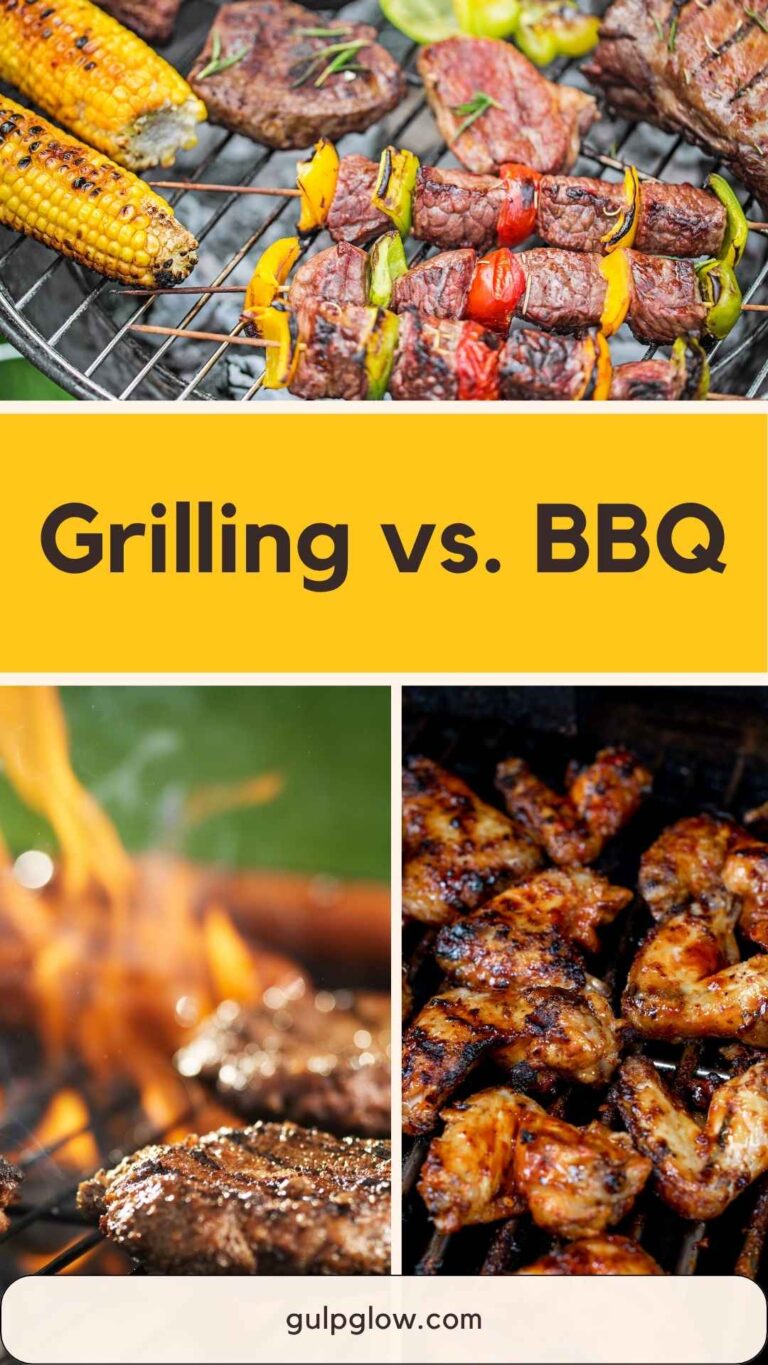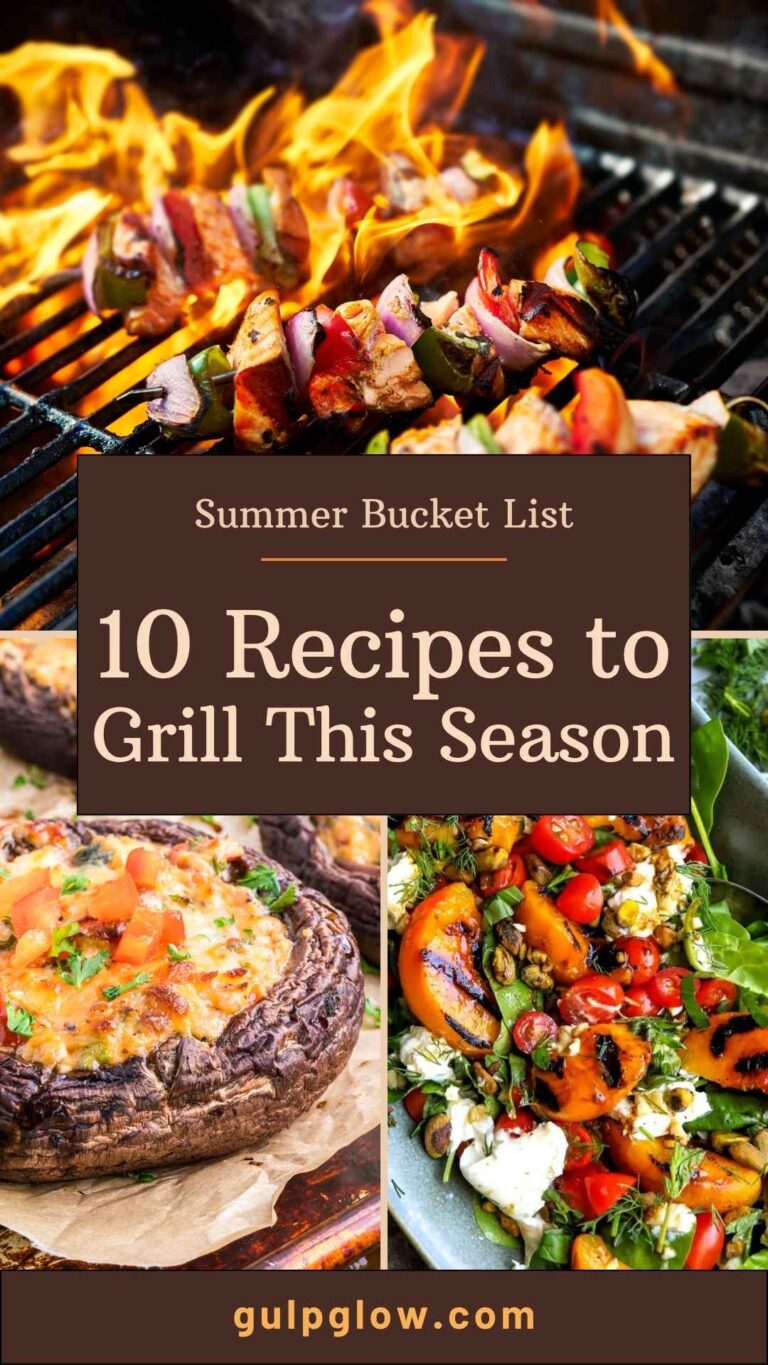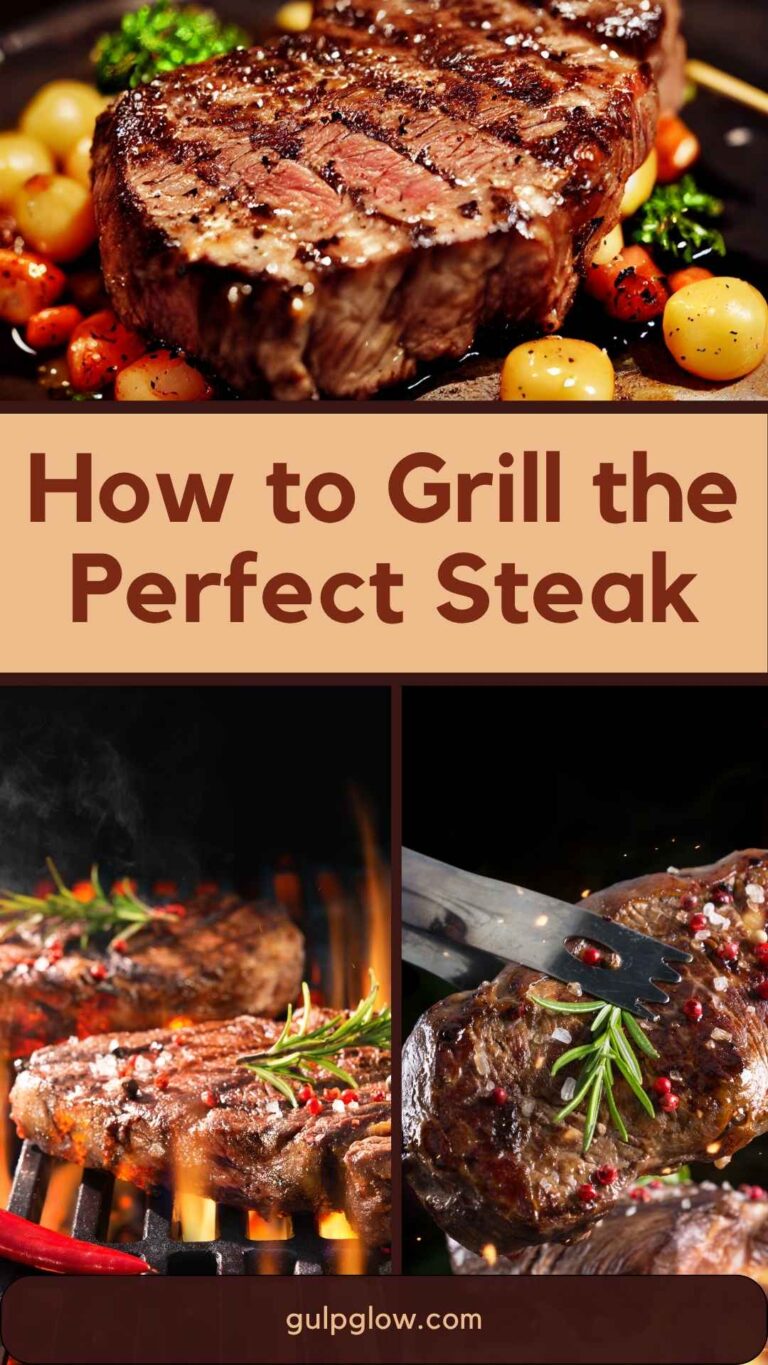Marinades vs. Dry Rubs: When to Use Each for Grilling
When it comes to grilling, the secret to unforgettable flavor often begins long before your food hits the flame. The two most common flavor-enhancing methods—marinades and dry rubs—can transform even the simplest cut of meat into something mouthwatering. But which one should you use, and when?
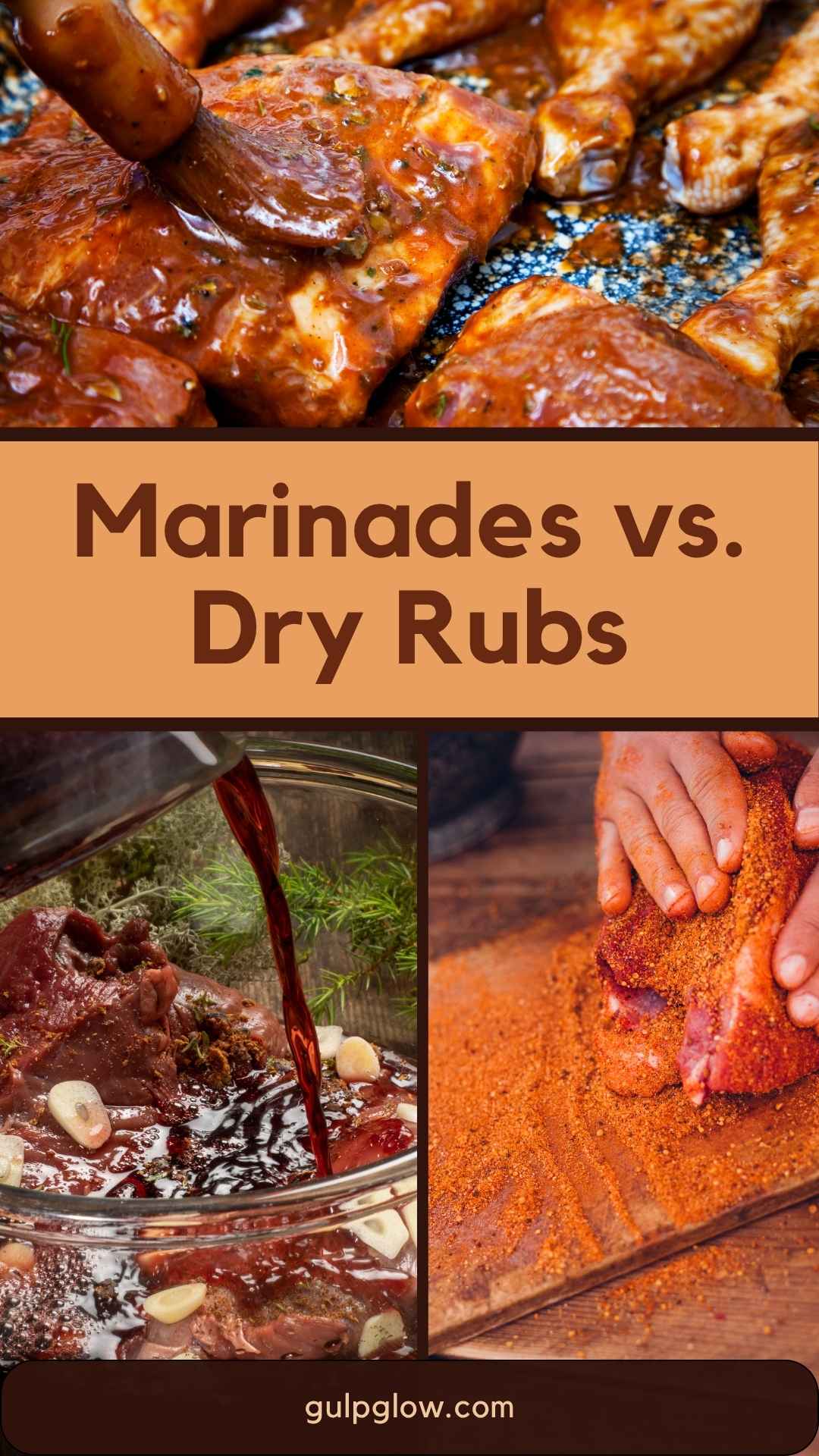
Marinades soak your food in a blend of liquids, acids, and aromatics to infuse it with moisture and flavor from the inside out. Dry rubs, on the other hand, are spice-based mixes applied to the surface of meat, creating a savory crust and locking in natural juices. Each has its strengths—and choosing the right one depends on your protein, prep time, and desired texture.
In this guide, we’ll break down how marinades and dry rubs work, when to use each method, and how to get the best results every time you fire up the grill. Whether you’re grilling juicy steaks, smoky ribs, or delicate fish, understanding these techniques will elevate your grilling game with every sizzle.
How Each Technique Works
Understanding the mechanics behind dry rubs and marinades is key to using them effectively. Both techniques season meat, but they do so in fundamentally different ways—each altering flavor, texture, and cooking results.
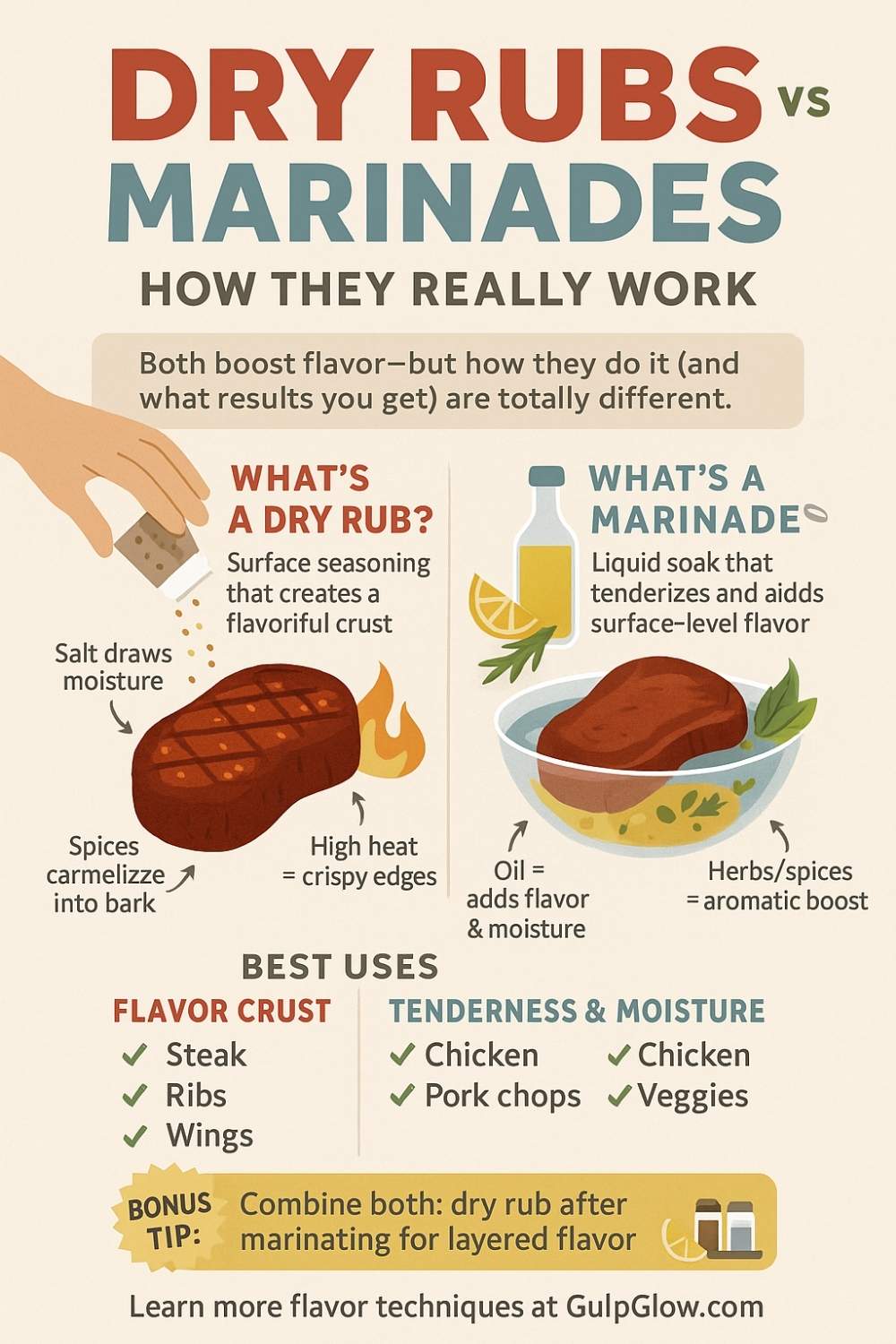
🔸 Dry Rubs: Surface Seasoning with Big Impact
A dry rub is a mixture of salt, sugar, herbs, and spices applied directly to the surface of meat or vegetables. Unlike marinades, rubs contain no liquid—they’re designed to stick and form a flavorful outer crust when exposed to high heat.
How it works:
- Salt pulls moisture from the surface, which then dissolves the spices slightly and helps them adhere.
- As the food grills, the sugars and spices caramelize and form a crust, known as the “bark.”
- This method delivers intense surface flavor without changing the meat’s internal texture.
Dry rubs are especially suited for foods where you want a crisp, flavorful exterior, like ribs, steak, or chicken wings.
🔸 Marinades: Deep Flavor and Tenderization
A marinade is a liquid mixture—typically made from acid (vinegar, citrus, yogurt), oil, herbs, and spices—that meat is soaked in for anywhere from 30 minutes to 24 hours.
What it does:
- Acids help break down muscle fibers, especially in tougher cuts, making them more tender.
- Oils carry fat-soluble flavors and prevent the meat from drying out.
- Herbs and spices infuse into the outer layers of the protein.
While marinades don’t usually penetrate deep into thick cuts, they’re excellent for adding moisture and boosting surface-level flavor—especially on lean or fast-cooking proteins.
Key Differences – Comparison Table
To better understand when to use each method, here’s a side-by-side comparison of the key differences between marinades and dry rubs:
| Feature | Dry Rub | Marinade |
|---|---|---|
| Form | Dry spices, no liquid | Liquid mixture with acid/oil/spices |
| Flavor Penetration | Surface-level | Shallow (outer layers only) |
| Texture Effect | Forms crust or bark | Can tenderize if acidic |
| Ideal Use | For crusty, seared texture | For moisture and flavor infusion |
| Best Cuts | Ribs, steak, chicken wings | Pork chops, chicken breasts, shrimp |
| Prep Time | 15 min to overnight | 30 min to 12 hrs depending on cut |
| Cooking Suitability | High-heat grilling and BBQ | Low to medium heat grilling or roasting |
| Mess Factor | Cleaner, less drip | Requires draining and can be messy |
This table helps visualize when each method works best—think of rubs for crisp, flavorful bark and marinades for juicy, tender bites.
Best Uses for Different Proteins
Choosing between a marinade or dry rub also depends heavily on the type of meat (or vegetable) you’re grilling. Each protein reacts differently to flavoring methods based on its texture and fat content.
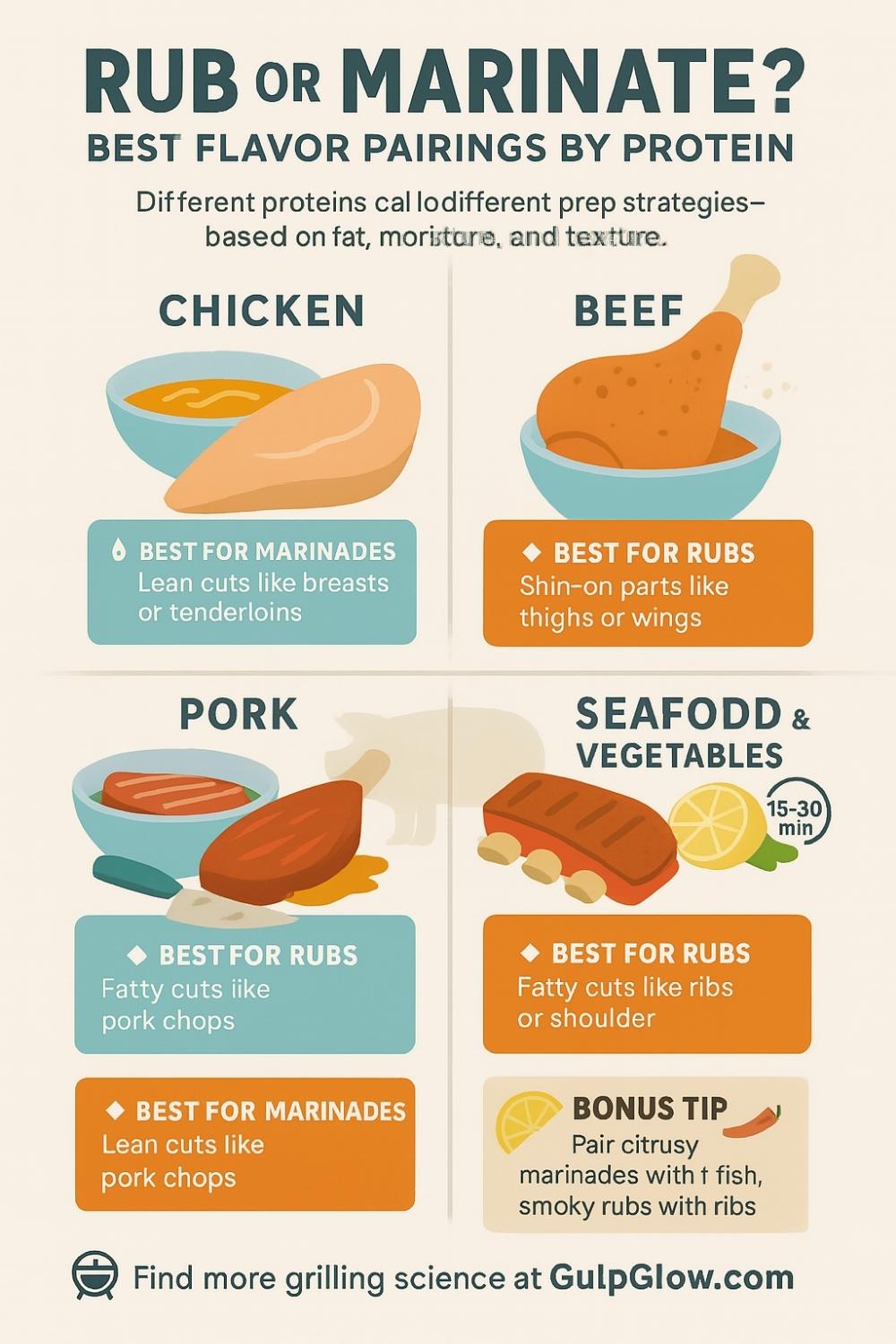
🐓 Chicken
- Best for Marinades: Lean cuts like breasts or tenderloins benefit from moisture and tenderizing effects.
- Best for Rubs: Skin-on parts like thighs or wings take rubs well and develop a crispy, seasoned crust.
🐄 Beef
- Best for Rubs: High-quality cuts like ribeye, T-bone, or NY strip don’t need tenderizing—rub enhances natural flavor.
- Marinades for Tough Cuts: Flank, skirt, or round steak respond well to marinades with acidic components.
🐖 Pork
- Dry Rubs: Pork ribs, belly, or shoulder thrive with bold, spicy-sweet rubs.
- Marinades: Lean cuts like pork chops benefit from soaking to stay juicy on the grill.
🐟 Seafood & Vegetables
- Quick Marinades: Seafood like shrimp or salmon soaks up flavor in as little as 15–30 minutes.
- Light Rubs: For veggies or dense fish (like tuna), a seasoning dust adds character without overpowering.
By tailoring your technique to the protein, you maximize flavor and get better results every time you grill.
When to Choose Marinade
Marinades are best used when you want to enhance moisture, add depth of flavor, or tenderize tougher or leaner cuts of meat. The liquid medium allows spices and acids to infuse into the outer layers, giving a juicy and well-rounded taste with every bite.
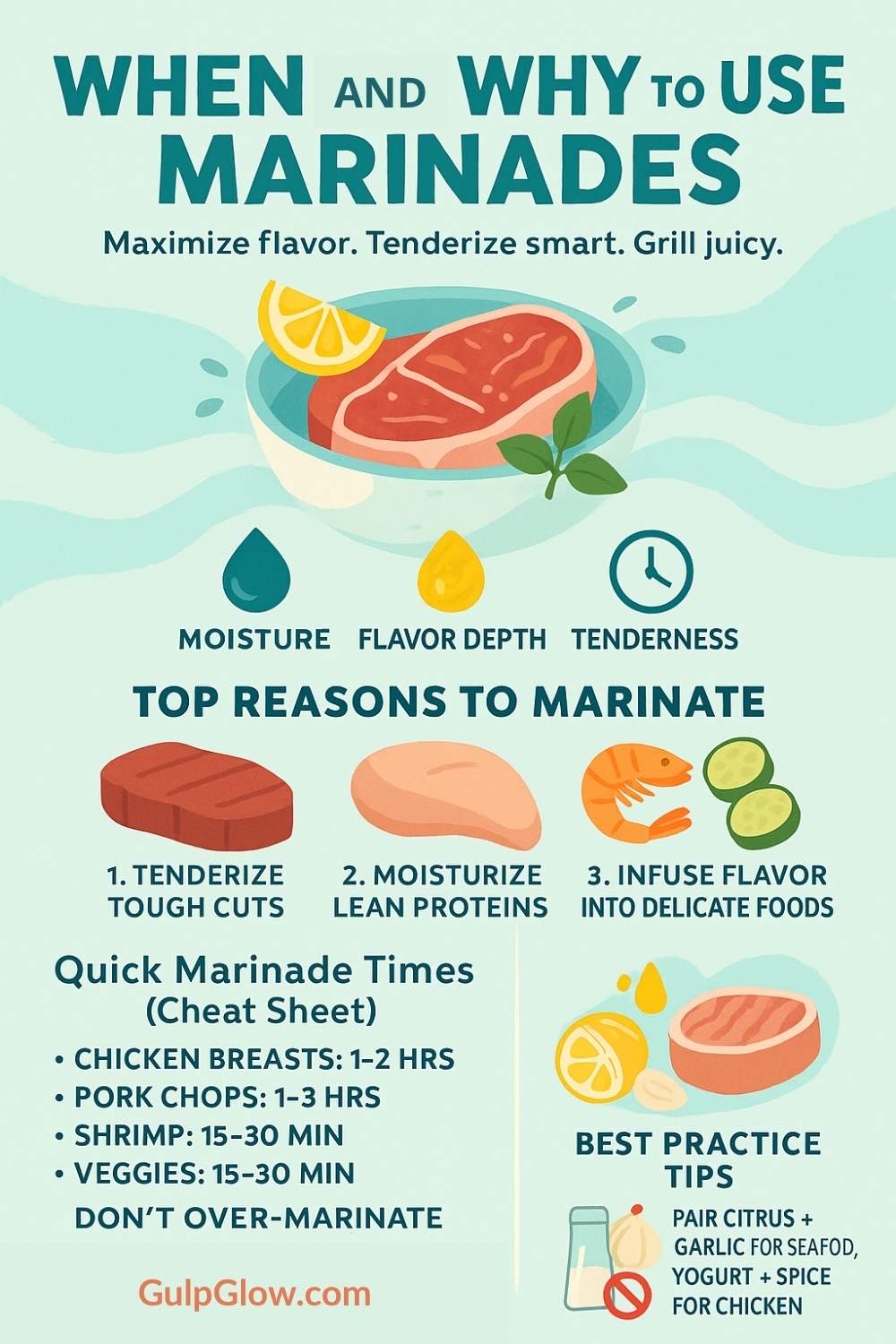
Ideal Scenarios for Marinades:
- Tough Cuts Needing Tenderization: Marinades containing acids (like vinegar, lemon juice, or yogurt) help break down muscle fibers in cuts such as flank steak, skirt steak, or pork shoulder.
- Lean Meats That Dry Out Easily: Chicken breasts, pork chops, and shrimp can dry out quickly on the grill. A marinade adds moisture and prevents that.
- Delicate Proteins and Vegetables: Seafood and veggies like mushrooms or zucchini absorb flavor quickly, making them ideal for short marinating sessions (15–30 minutes).
Best Practice Tips:
- Don’t marinate too long—especially with acidic bases—as it can make the meat mushy.
- Always refrigerate marinating meat to prevent bacterial growth.
- Pat meat dry before grilling to avoid flare-ups and promote browning.
A well-balanced marinade is like a flavor bath—it tenderizes while enhancing the natural character of your meat.
When to Opt for Dry Rub
Dry rubs are your go-to when you want bold surface flavor, a crispy crust, and more control over texture. Since there’s no added moisture, rubs help the meat sear better and caramelize under high heat, especially on open flames.
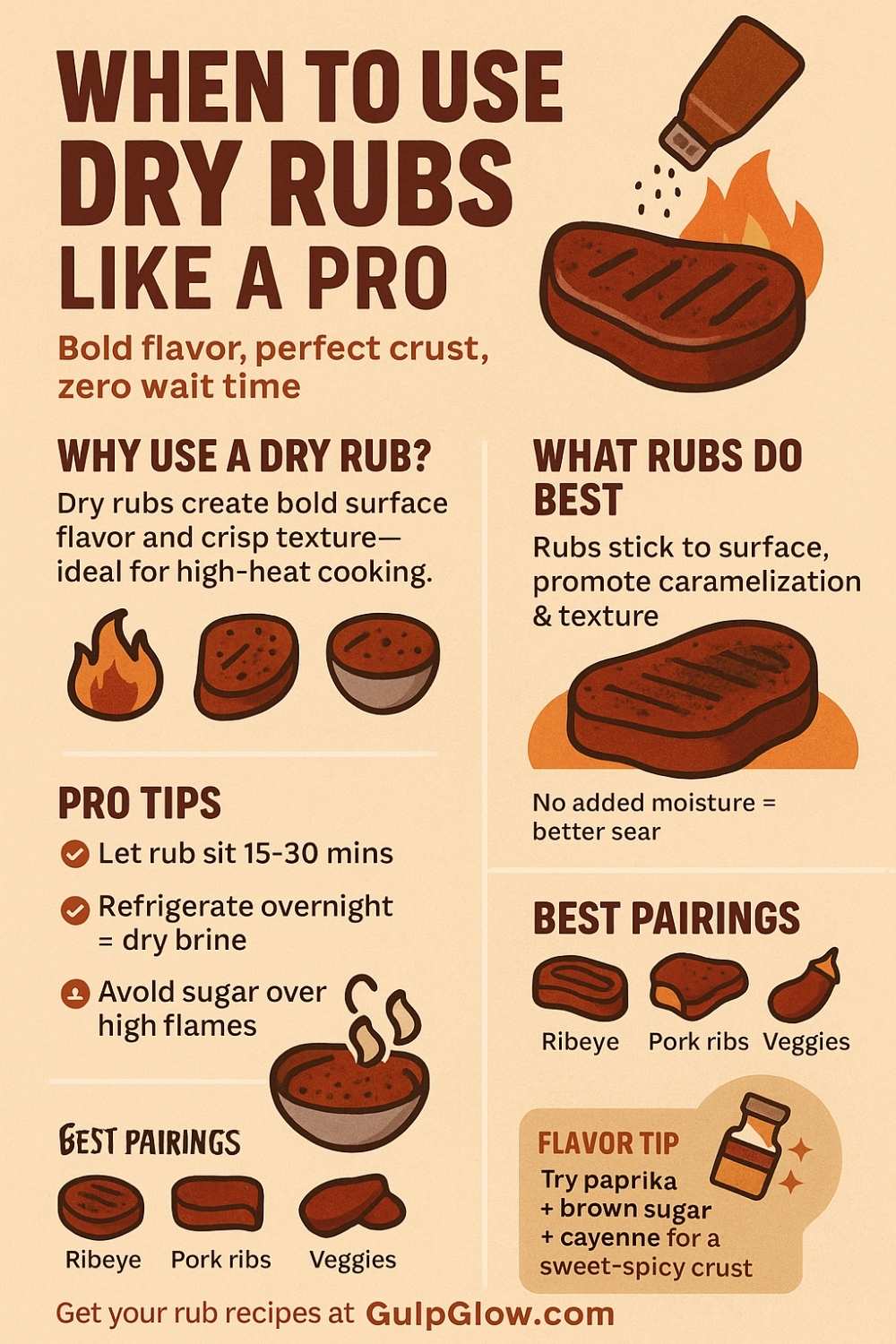
When Dry Rubs Excel:
- Quick Weeknight Grilling: Rubs are fast to apply and don’t require soaking time—ideal for last-minute grilling.
- Meats with High Fat Content: Ribeye steaks, chicken thighs, and pork ribs already have internal moisture. A rub enhances the exterior without interfering.
- BBQ & Smoking: Rubs form the signature bark in low-and-slow cooking, especially when combined with smoke.
Best Practice Tips:
- Apply rubs at least 15–30 minutes before grilling for deeper flavor.
- For extra impact, apply rub and refrigerate overnight (known as a “dry brine” if it includes salt).
- Use sugar-based rubs with caution over high heat—they can burn quickly.
Dry rubs offer punchy flavor and great texture, making them a favorite for grilling enthusiasts who love a seared, crusty finish.
Hybrid Methods: The Best of Both
Can you use a marinade and a dry rub together? Absolutely—but it takes a little finesse. When done right, combining both methods gives you the deep flavor of a marinade with the bold finish of a rub.
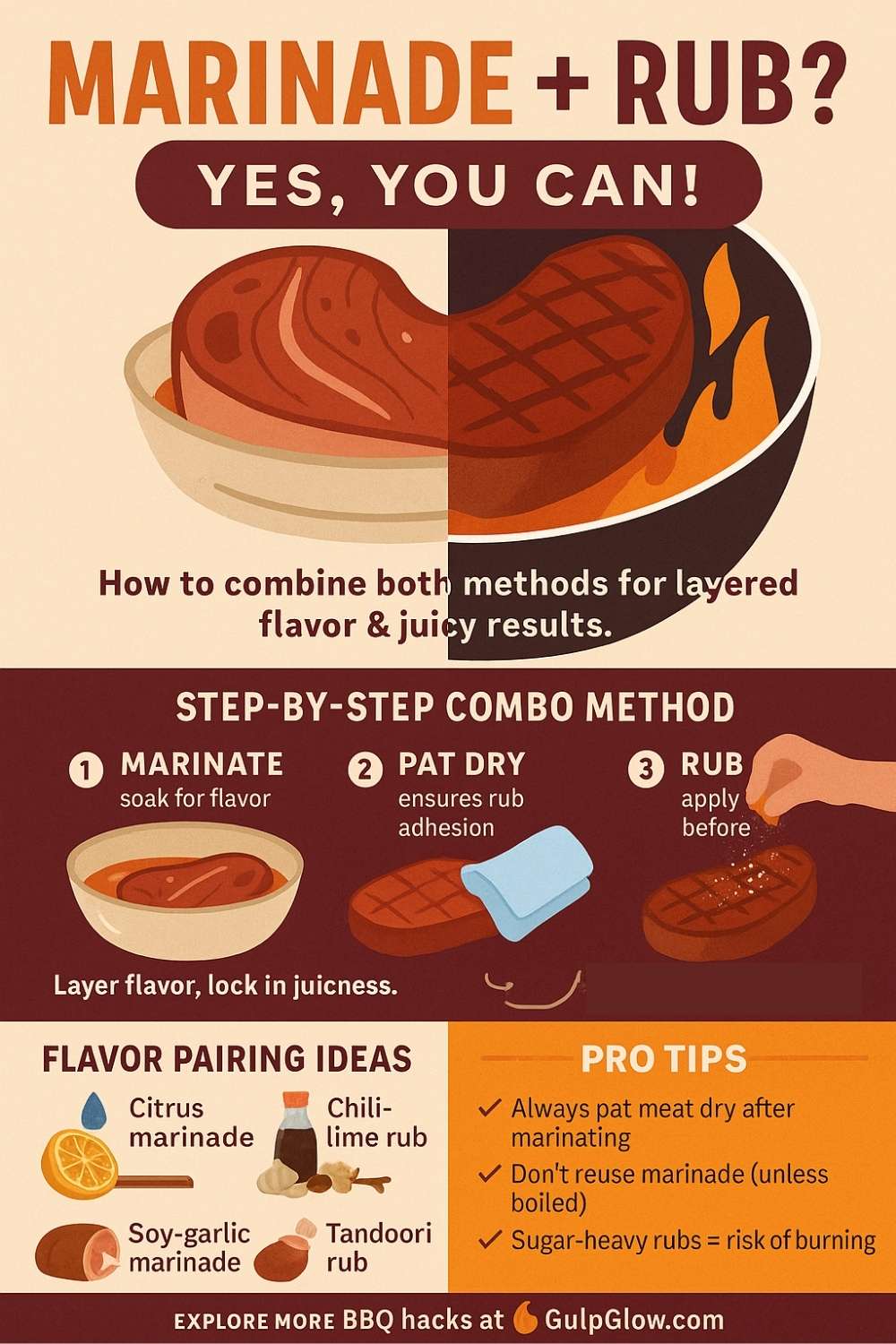
How to Combine Them:
- Marinate First: Soak the meat in a marinade to build internal moisture and base flavor. This can range from 30 minutes to several hours depending on the protein.
- Dry Before Applying Rub: After removing from the marinade, pat the meat dry to ensure the rub sticks and sears properly.
- Apply Rub Before Grilling: Use a light to medium coat of dry rub just before the meat hits the grill.
Pro Tips:
- Choose complementary flavors: a citrusy marinade pairs well with a chili-lime rub; a soy-based marinade with an Asian-style five-spice rub.
- Discard used marinade unless it’s boiled for use as a sauce—this avoids cross-contamination.
- Keep sugar content moderate in the rub to prevent burning during grilling.
The hybrid approach is perfect for larger cuts, longer grills, or when you want a layered flavor profile that evolves with every bite.
Ingredients & Flavor Profiling
Choosing the right ingredients for your marinade or dry rub is just as important as selecting the right protein. Each element in your seasoning contributes to flavor, texture, and even the cooking process. Let’s look at how each method builds its unique flavor profile.
Building Blocks of a Great Dry Rub
Dry rubs are all about bold, concentrated flavor that sticks to the meat and reacts beautifully with heat. A typical rub is made up of:
- Salt – Enhances natural flavor and draws out surface moisture.
- Sugar – Helps with caramelization and balances out spice (use cautiously on high heat to avoid burning).
- Spices – Think paprika, garlic powder, cumin, chili powder, and black pepper.
- Herbs – Dried thyme, rosemary, oregano add depth.
- Heat – Crushed red pepper, cayenne, or mustard powder for a spicy kick.
Here’s a quick look at rub flavor profiles by cuisine:
| Cuisine Style | Common Rub Ingredients |
|---|---|
| BBQ (Southern US) | Brown sugar, paprika, garlic powder, chili |
| Caribbean | Allspice, cinnamon, cayenne, dried thyme |
| Tex-Mex | Cumin, oregano, smoked paprika, chili powder |
Essentials of a Flavorful Marinade
A marinade uses liquid to deliver flavor deeper into the food’s surface while also tenderizing certain cuts. The base is usually made up of three parts:
- Acid – Vinegar, lemon juice, lime, wine, or yogurt help break down tough fibers.
- Oil – Olive oil, sesame oil, or neutral oils help distribute flavors and retain moisture.
- Aromatics & Spices – Garlic, onions, soy sauce, herbs, mustard, honey—this is where the magic happens.
Popular regional marinade styles:
| Region | Signature Ingredients |
|---|---|
| Asian | Soy sauce, ginger, garlic, rice vinegar, sesame oil |
| Mediterranean | Olive oil, lemon juice, oregano, garlic |
| Latin American | Citrus juices, cilantro, cumin, chili, garlic |
When you understand the building blocks, you can mix and match to create custom flavor experiences based on your cooking style or cultural preference.
Timing & Practical Tips
Timing is everything when it comes to both marinades and rubs. Over-seasoning or under-resting can make or break your dish. Let’s explore how long you should apply each method and practical tips to make the process seamless.
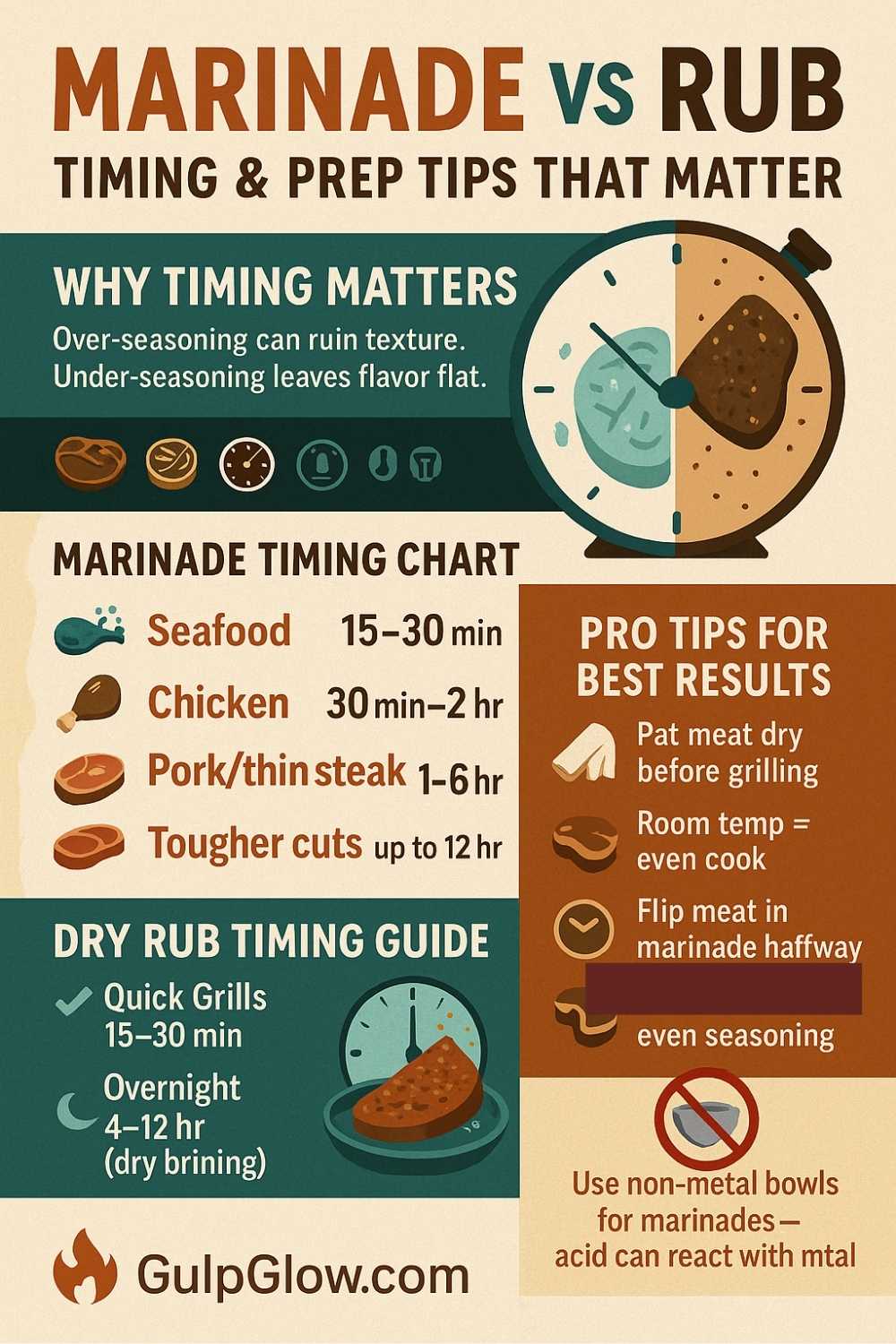
Timing Guidelines for Marinades
Marinating is most effective when you allow enough time for the acids and oils to work their magic—but not too long, or you risk ruining texture.
Ideal marinating durations:
- Seafood – 15 to 30 minutes (over-marinating can “cook” the protein)
- Chicken (breast/thighs) – 30 minutes to 2 hours
- Pork chops or thin steaks – 1 to 6 hours
- Tougher cuts (flank, skirt, shoulder) – Up to 12 hours
Always marinate in the refrigerator, and use non-metal containers like glass or resealable plastic bags to avoid chemical reactions with acidic ingredients.
Timing Guidelines for Dry Rubs
Dry rubs work quickly but can also benefit from extra time to settle and interact with the meat’s surface.
Recommended dry rub timing:
- Quick Grills – Apply 15 to 30 minutes before cooking.
- Enhanced Flavor – Apply rub and refrigerate for 4 to 12 hours for deeper penetration (especially if the rub includes salt—a technique known as “dry brining”).
Pro Tips for Smooth Prep
- Pat meat dry before applying rub or grilling after marinating—this improves browning and prevents flare-ups.
- Let meat come to room temperature for 20–30 minutes before grilling to ensure even cooking.
- Use uniform cuts so that flavor and heat distribute evenly.
- For marinades, flip halfway through soaking to ensure all sides absorb equally.
These tips not only improve flavor but also streamline your workflow at the grill.
Safety & Health Tips
Seasoning your food is delicious, but doing it safely is non-negotiable. Both marinades and rubs come with best practices to prevent contamination, improve storage, and promote healthier grilling overall.
Marinade Safety Basics
Marinades involve raw meat and liquids, which means bacteria can spread quickly if handled carelessly. Follow these rules:
- Never reuse marinade unless you boil it for at least 5 minutes to kill bacteria.
- Marinate in the fridge, not on the counter, to prevent foodborne illness.
- Use glass, ceramic, or food-grade plastic containers—never metal with acidic marinades.
- Avoid over-marinating—especially for delicate proteins. Acid can start to break them down too much, making the texture mushy or unpleasant.
Safe Handling of Dry Rubs
Dry rubs are easier to manage but still require caution, especially when cross-contamination is a risk.
- Use clean hands or utensils to apply rubs.
- Never touch your rub container after handling raw meat—pour some into a small bowl beforehand.
- Label and store homemade rubs in a cool, dry place to preserve freshness and prevent mold.
Tips for Healthier Seasoning
- Choose low-sodium spice blends or make your own to control salt content.
- Opt for natural sweeteners like honey or maple syrup in marinades.
- Add citrus zest, herbs, and vinegar for bright flavor instead of relying solely on salt or sugar.
By treating flavoring as a part of your food safety protocol—not just your recipe—you’ll end up with meals that are both safe and satisfying.
Conclusion & Quick Decision Guide
Grilling is more than just tossing meat over flames—it’s a flavorful craft that begins long before the fire is lit. Choosing between a marinade and a dry rub is not just about preference—it’s about understanding your protein, your time constraints, and your desired flavor and texture outcome.
Both techniques offer distinct benefits. Marinades are perfect for lean or tough cuts that need moisture and tenderness. They add layers of flavor and soften the outer layers of meat. Dry rubs, on the other hand, deliver concentrated surface seasoning, crisp up beautifully over high heat, and give grilled meats a signature crust that’s packed with punch.
Still not sure which to choose? Use this quick decision guide as your cheat sheet:
🔍 Quick Decision Guide: Marinade or Dry Rub?
| Question | If YES → Use This | Why |
|---|---|---|
| Is your meat lean or prone to drying out? | Marinade | Adds moisture and prevents drying |
| Are you grilling seafood or delicate proteins? | Marinade | Infuses quick flavor without overpowering texture |
| Do you want a crusty, flavorful surface? | Dry Rub | Caramelizes and creates texture |
| Are you cooking a premium cut (like ribeye)? | Dry Rub | Enhances natural flavor without masking it |
| Are you short on prep time? | Dry Rub | Fast to apply and ready to grill |
| Are you cooking low and slow? | Either or Both | Combine methods for deep flavor + bark |
| Do you want a bold, regional flavor style? | Either | Customize with spices (rub) or herbs (marinade) |
Whether you’re preparing for a quick weeknight dinner or an all-day backyard feast, knowing how and when to use marinades and rubs puts you in full control of your flavor. Mix, match, experiment—and don’t be afraid to combine the two for the best of both grilling worlds.
Now you’re armed with the knowledge to make every grilled dish a showstopper.

